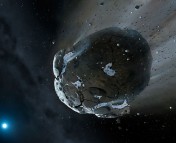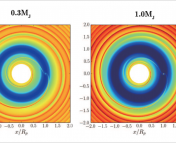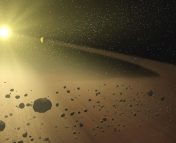Title: The Boundary Between Gas-rich and Gas-poor Planets
Author: Eve J. Lee
First Author’s Institution: California Institute of Technology, Pasadena, CA
Status: Accepted to The Astrophysical Journal, open access
Astronomers often compare exoplanets to the planets in our own Solar System — Jupiters, Neptunes, super-Earths, etc. — because they are familiar. But the distinction can be made even simpler: planets that are gas-rich, and those that are not. Where does the boundary between the two fall, and how does it arise? Today’s paper addresses that very question.
An Excess of Sub-Saturn Planets
The most successful theory of planet formation to date is that of core accretion (Figure 1). In this theory, planets first form as rocky cores embedded within the star’s gas disk. As the core cools, the decreased thermal pressure allows more and more gas to accrete onto the core. The outward thermal pressure of the atmosphere supports additional accreted gas in hydrostatic equilibrium until the mass of the gas envelope approaches the core mass. After this critical point, the system experiences runaway accretion and the planet becomes a gas-rich giant planet. Critically, runaway accretion occurs only if the core and atmosphere become massive enough before the end of the typical 10-million-year lifespan of the gas disk. More massive cores will accrete gas faster and therefore be more likely to trigger runaway accretion before the dissipation of the gas disk.
The core accretion story of planet formation results in a binary picture of planets: those with large gaseous envelopes relative to their cores, and those with small envelopes. But what about the planets in the middle? The core accretion model suggests that we should expect to find a lot of Jupiters (, where
is Earth’s radius) and a lot of Neptunes or rocky planets (
), but not much in between. However, these “sub-Saturns,” which are on the verge of runaway accretion with gas-to-core mass ratios (GCRs) of ~0.1-1.0, are observed at the same rate as gas giants!
Gassy…or not?
The fact that sub-Saturns are observed as often as gas giants suggests that the story is a bit more complicated. The cooling of the core is not the only process that must be considered when simulating the formation of planets in a gas disk. Complex interactions between the gas in the planet’s atmosphere and the gas remaining in the disk can play a large role in a planet’s ultimate fate.
To quantify the effects of these additional processes, Lee ran a series of planetary formation simulations. She first determined the best-fit core mass distribution through comparison with observations. Notably, this paper is the first time a single core mass distribution reproduced both the observed plethora of sub-Neptunes and the similar numbers of gas giants and sub-Saturns (see Equation 5 in the paper). Considering planets with orbital periods between 10-300 days, Lee generated a range of planetary cores with masses from (where
is Earth’s mass) from the best-fit core mass model. These cores were placed in a gas disk at uniform times between 0 to 12 million years and evolved until the end of the 12 million years. The bottom line is perhaps unsurprising: the planet’s fate depended both on the initial core mass and when during the disk’s lifetime the planet formed.
More interestingly, by taking into account processes beyond cooling, Lee’s simulations resolved the discrepancy between the expected and observed number of sub-Saturns. The simulations also revealed four distinct core mass ranges that ultimately result in different planet types (see Figure 2):
A. Core masses can only accrete a small amount of gas through cooling and remain sub-Neptunes and super-Earths.
B. Core masses between accrete gas through cooling until the gas disk dissipates, while interactions between the atmosphere and gas disk decrease the amount of gas that falls onto the core. These planets do not reach runaway accretion and so remain sub-Saturns.
C. Core masses between experience runaway accretion but growth is ultimately stymied by fluid interactions between the planet’s atmosphere and the gas disk. These planets become Jupiters.
D. Core masses accrete gas so quickly that they carve deep gaps in the disk and ultimately deprive themselves of further accretion. These planets are massive Jupiters.
Figure 2 shows the wide variety of planets that can be formed given an initial core mass and time available for gas accretion. In particular, more massive cores can span the full GCR range depending on when they formed, becoming gas-rich or gas-poor planets. Conversely, low mass cores will only ever become gas-poor planets. This provides a potential explanation for why metal-rich solar systems with more massive elements appear to host a wider variety of planets.
The Gassy Conclusion
Today’s paper is the first study that is consistent with observations across all core mass ranges. Furthermore, Lee shows the importance of including the fluid interactions between the planet’s atmosphere and the gas disk, resolving the discrepancy between the expected and observed number of sub-Saturns. As both observational and computational techniques improve, we will move closer to a comprehensive and complete description of planet formation.




